Overview
The article titled "10 Key Commercial Real Estate Industry Trends to Watch in 2025" aims to identify and analyze significant trends poised to shape the commercial real estate sector in 2025. It outlines various trends, including:
- The rise of move-in ready offices
- The resurgence of retail
- The emphasis on ESG considerations
- The impact of technology through PropTech
These trends underscore the evolving landscape of the industry and highlight the necessity for stakeholders to adapt to these changes to achieve sustained success.
Introduction
In the dynamic landscape of real estate, staying informed is paramount for both industry professionals and enthusiasts. As market trends shift and consumer behaviors evolve, resources that provide timely insights have become essential. Enter Zero Flux, a specialized daily newsletter that curates critical real estate information from over 100 diverse sources. With a commitment to factual reporting, Zero Flux delivers a concise compilation of handpicked insights that empower its growing community of over 30,000 subscribers to navigate the complexities of the market.
From highlighting affordable housing opportunities to emphasizing the importance of data-driven decision-making, this newsletter serves as a vital tool for investors and stakeholders aiming to stay ahead in a competitive environment. As the real estate sector adapts to new challenges and opportunities, the insights offered by Zero Flux are more relevant than ever, paving the way for informed investments and strategic growth.
Zero Flux: Your Daily Source for Essential Real Estate Insights
Zero Flux is a focused daily newsletter that consolidates significant insights and trends from the commercial real estate industry gathered from over 100 diverse sources. By emphasizing factual information devoid of opinions, it serves as an essential resource for industry professionals and enthusiasts alike. Subscribers receive a concise selection of 5-12 curated insights daily, covering topics such as:
- Housing trends
- Investment opportunities
- Demographic shifts
This data-driven approach empowers its growing audience of more than 30,000 subscribers to navigate the complexities of the property sector with efficiency, especially as the newsletter highlights commercial real estate industry trends, including affordable housing, and identifies cities like Detroit, Michigan, and Cleveland, Ohio, as some of the most economical locations for homeownership. Furthermore, Zero Flux's commitment to delivering high-quality content enhances subscriber engagement, establishing it as a leading authority in property information dissemination. As a practical recommendation, real estate stakeholders should leverage the insights provided by Zero Flux to identify emerging sectors and investment opportunities in alignment with commercial real estate industry trends, ensuring they maintain a competitive edge in the market.
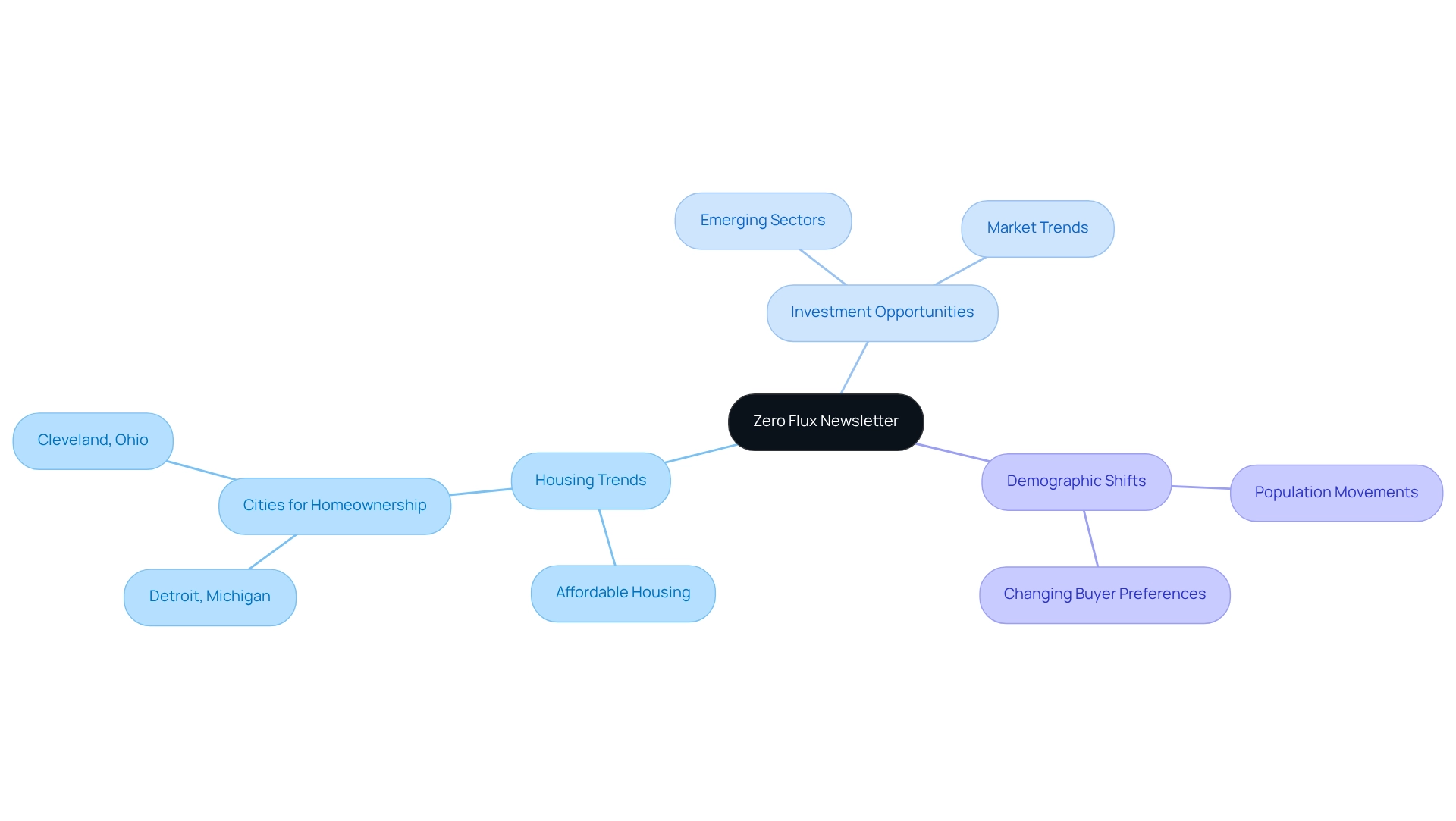
Move-In Ready Offices: Meeting the Demand for Flexible Workspaces
As companies increasingly adopt hybrid work models, the demand for move-in ready offices is experiencing significant growth. These spaces provide businesses with the flexibility to adapt swiftly, eliminating the long-term commitment associated with traditional leases. Recent reports reveal that 83% of employees favor hybrid work as their ideal arrangement, underscoring the necessity for fully furnished and equipped office spaces that facilitate immediate occupancy and operational efficiency.
Moreover, a case study titled "Future Trends in Hybrid Work" indicates that as hybrid work becomes prevalent, 40% of office interactions now involve remote participants, highlighting the urgent need for adaptable work environments. This trend, reflected in commercial real estate industry trends, is reshaping the office sector, prompting landlords to invest more in ready-to-use spaces to align with tenant expectations.
To remain competitive in this evolving landscape, companies must prioritize employee satisfaction and operational efficiency during their transition to hybrid work.
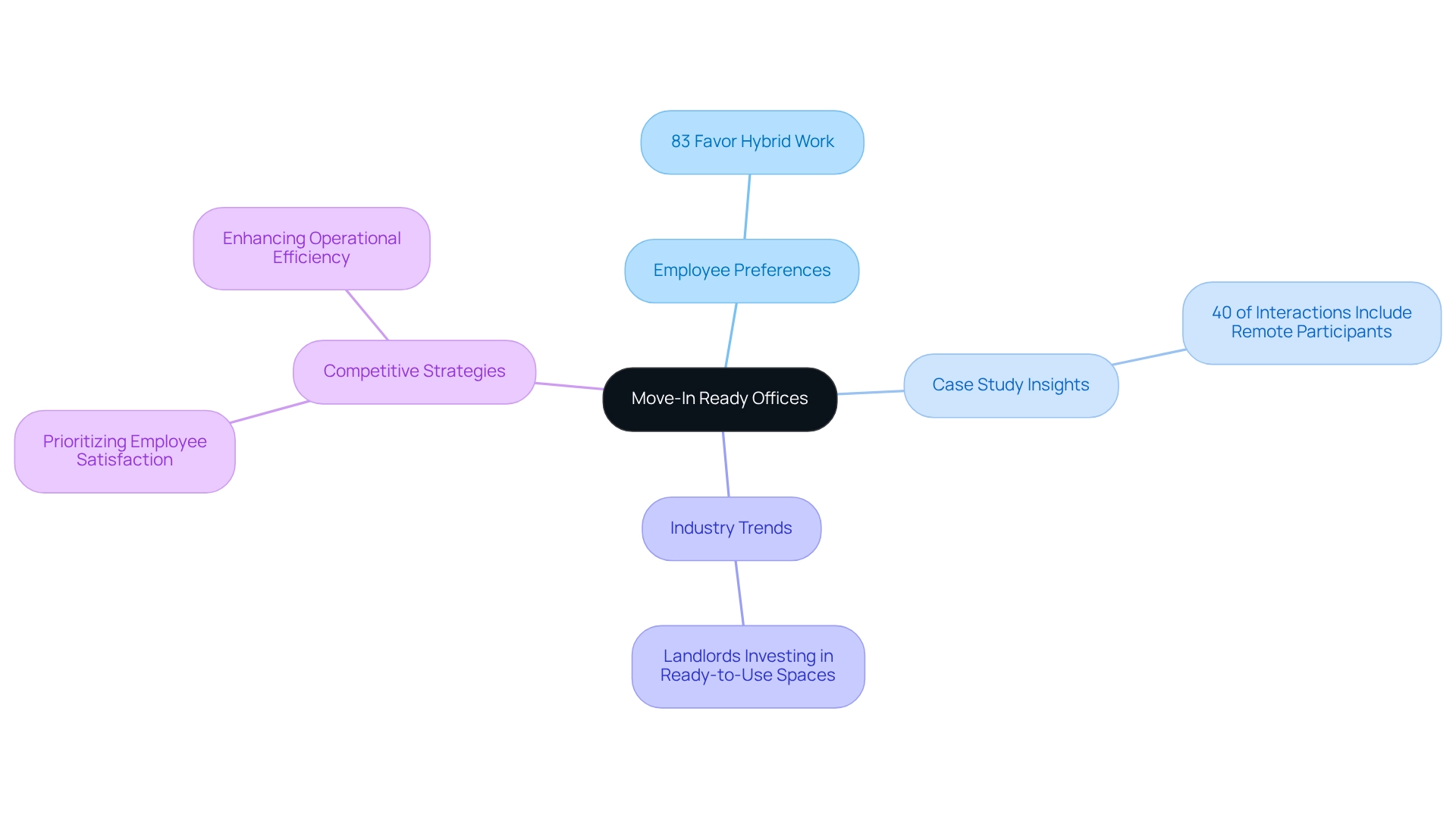
Resurgence of Retail: Adapting to New Consumer Behaviors
The retail sector is witnessing a remarkable resurgence as businesses adapt to shifting consumer behaviors shaped by the pandemic. A pronounced emphasis on experiential shopping and personalized services is compelling retailers to reevaluate their strategies to enhance customer engagement. Consequently, brick-and-mortar stores are evolving to offer distinctive experiences that online platforms cannot replicate. This transformation is evidenced by declining vacancy rates, closely linked to rising foot traffic and reports indicating a revival in physical store visits anticipated in 2025.
For stakeholders, this transition presents a compelling opportunity to capitalize on revitalized retail environments that cater to the changing preferences of shoppers, particularly those appealing to value-seeking clients and facilitating omnichannel functionalities. Current statistics reveal that 69% of retail executives recognize strained consumer trust stemming from technological advancements, underscoring the necessity for retailers to cultivate authentic connections with their customers.
Moreover, expert insights indicate that the post-COVID-19 landscape will witness a bifurcation in retail outcomes, accentuating the need to stand out in a competitive market. As retailers navigate these dynamics, strategies focused on operational efficiency are emerging as crucial trends. These approaches not only enhance operational effectiveness but also significantly elevate the overall consumer experience, positioning the retail sector for sustained growth and resilience in the years ahead.
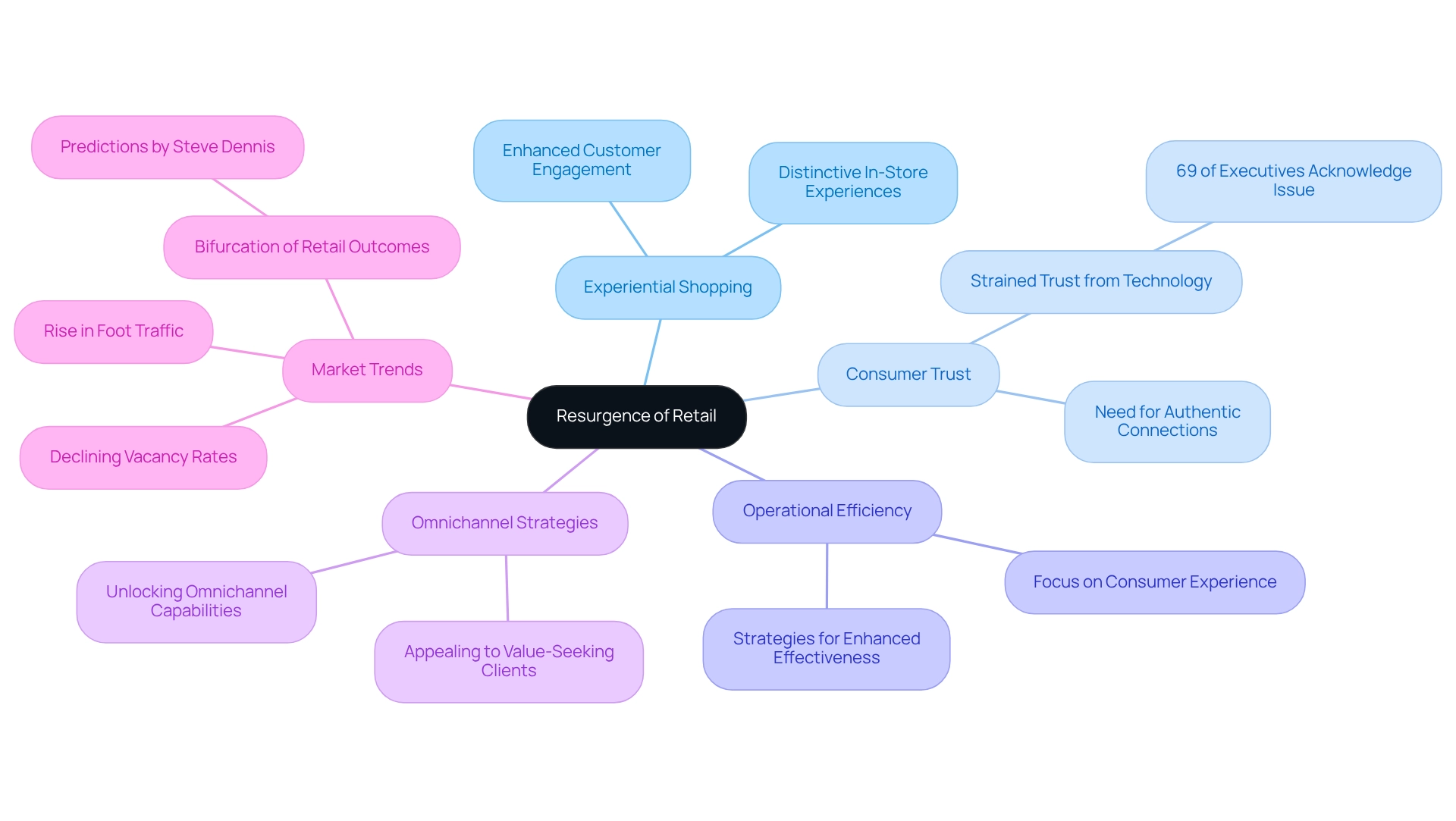
ESG Considerations: Prioritizing Sustainability in Real Estate Investments
In 2025, ESG considerations are emerging as a pivotal focus for stakeholders in real estate. Properties that adhere to sustainability standards not only attract tenants more effectively but also benefit from reduced operational costs and enhanced long-term value. A significant shift is underway, with investors increasingly favoring developments that embrace green building practices, energy efficiency, and community engagement. This trend aligns with a broader movement towards responsible investing, where stakeholders aim to harmonize profitability with positive social impact.
Sustainable construction is becoming the default approach, driven by consumer demand and evolving market dynamics. Notably, sustainable funds are outperforming traditional investment options, as recent analyses indicate that these funds are adapting to sustainability imperatives. This underscores the financial sustainability of eco-friendly methods in the property sector. As cultural leaders promote a societal shift towards sustainability, the property sector is responding by prioritizing developments that embody these values, which in turn impacts investment strategies.
Statistics reveal that consultants utilizing automation to measure emissions can achieve up to a 100-fold increase in data points for each calculation, showcasing the growing sophistication in assessing sustainability metrics. Additionally, expert views highlight that 55% of consumers regard environmental responsibility as vital when choosing brands, suggesting a strong consumer preference for sustainable practices. This consumer sentiment increasingly affects property investment choices, as assets that align with these values tend to perform better in the market.
As we progress through 2025, the impact of sustainability on property values is becoming more apparent. ESG considerations are shaping investment strategies and influencing trends in the commercial real estate industry. Investors are motivated to integrate these factors into their strategies, acknowledging that sustainability is not merely a fad but a crucial driver of value within the commercial real estate industry trends.
PropTech Revolution: Embracing Technology in Real Estate Management
The PropTech revolution is fundamentally transforming the property landscape in 2025, reflecting significant commercial real estate industry trends that position technology as a pivotal element in property management and tenant engagement. Innovations such as AI-driven analytics, smart building technologies, and virtual reality tours are not only enhancing operational efficiencies but also significantly improving tenant experiences. For example, 29% of companies are currently piloting smart contracts, highlighting a shift towards more automated and secure transactions. As property managers increasingly adopt these technologies, they can streamline processes and reduce operational costs while delivering superior services.
The PropTech funding confidence index currently stands at 6.5, reflecting a cautious yet optimistic outlook among investors regarding future innovations in this sector. This growing confidence suggests a robust potential for increased investment and growth in PropTech, reflecting the commercial real estate industry trends, as companies continue to develop and implement new technologies that redefine property management. Moreover, with the property sector projected to approach nearly $5,871 billion by 2029, driven by technological advancements, the incorporation of these innovations is poised to play a crucial role in shaping the future of property management.
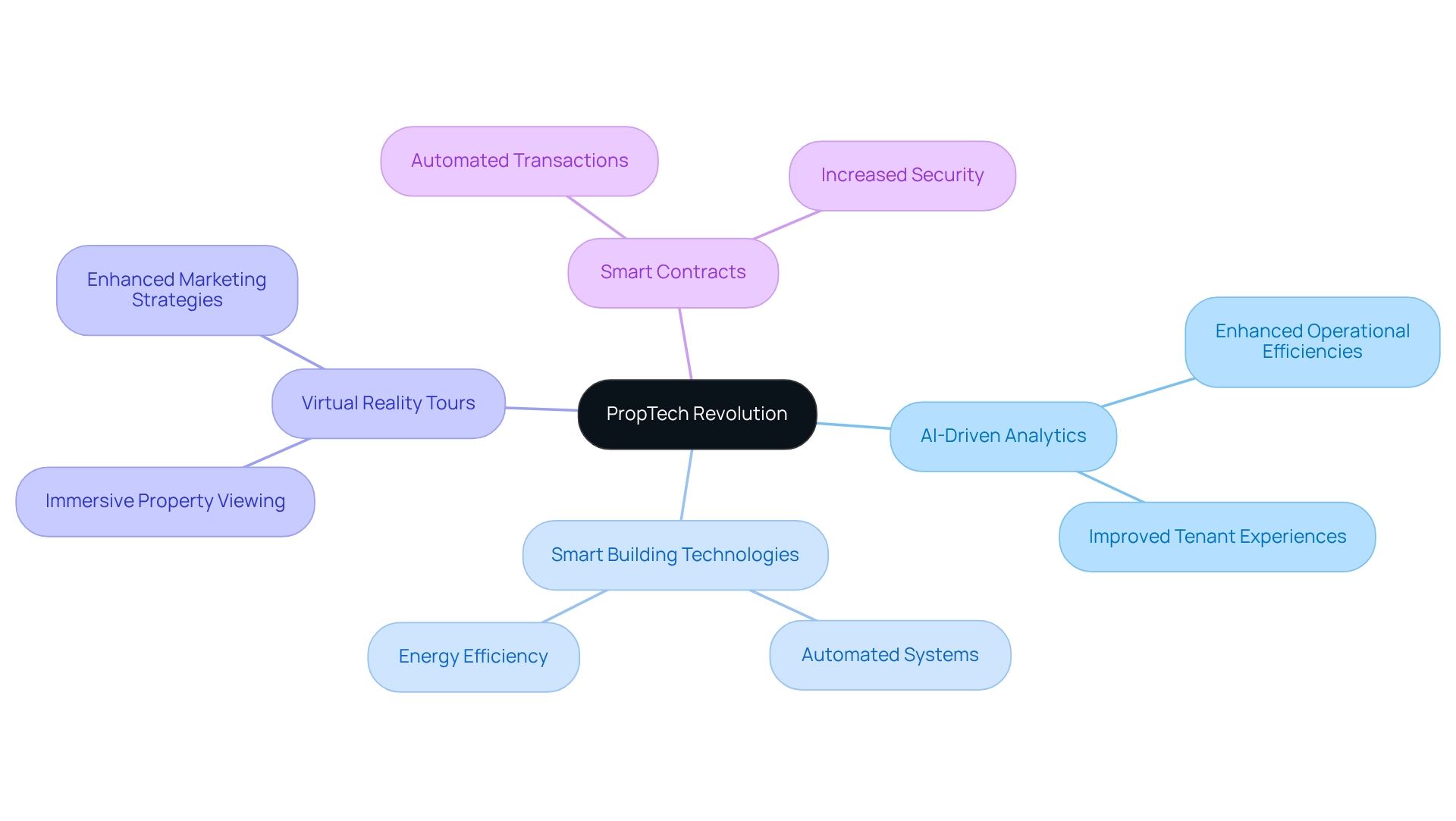
Operational Real Estate: Growth in Specialized Property Types
In 2025, the functional property sector is poised for significant expansion as financiers increasingly focus on specialized asset categories that meet specific consumer needs. Sectors such as data centers, logistics facilities, and healthcare properties are experiencing remarkable growth, propelled by the surge in e-commerce and the rising demand for healthcare services.
For instance, the demand for data centers is projected to escalate, driven by the ongoing digital transformation and the proliferation of cloud computing. Similarly, logistics facilities are becoming indispensable as supply chains adapt to the evolving e-commerce landscape, which aligns with commercial real estate industry trends that present unique investment opportunities, including affordable housing and public-private partnerships.
Investors are prioritizing properties that align with current societal needs, such as affordable housing and sustainable development. Notably, more than 61% of investors now emphasize Building Performance Standards during due diligence, indicating a growing focus on environmental and social impact in investment decisions.
As the operational property sector evolves, stakeholders are encouraged to explore these emerging opportunities to diversify their portfolios and capitalize on the changing landscape. The integration of data-driven insights will be essential, as property firms acknowledge the importance of data quality and preparedness in effectively navigating these trends. However, potential risks remain due to shifting economic policies and ongoing population migration patterns, which could influence the new property cycle in 2025.

Data-Driven Insights: Leveraging Analytics for Real Estate Decisions
In the evolving landscape of property, data-informed insights have become indispensable for experts aiming to make knowledgeable decisions. By 2025, the fusion of big data and predictive analytics will empower stakeholders to identify commercial real estate industry trends, assess property values, and foresee market shifts with unmatched accuracy. This analytical methodology not only bolsters decision-making but also provides stakeholders with a competitive edge in a swiftly changing environment.
As Mark Twain wisely cautioned, gathering data without a clear strategy renders it ineffective, underscoring the necessity for specific inquiries to direct data collection efforts. With over 30,000 subscribers relying on Zero Flux for precise insights, property stakeholders will increasingly leverage these data-informed perspectives to navigate challenges and refine their investment strategies.
Furthermore, as Josh Wills pointed out, mastering both statistics and engineering is essential for proficient data analysis, highlighting the significance of a well-rounded approach in this domain. Additionally, the case study elucidating the role of a data scientist illustrates the blend of skills essential for success in data analytics, reaffirming the critical role of data in property decision-making.
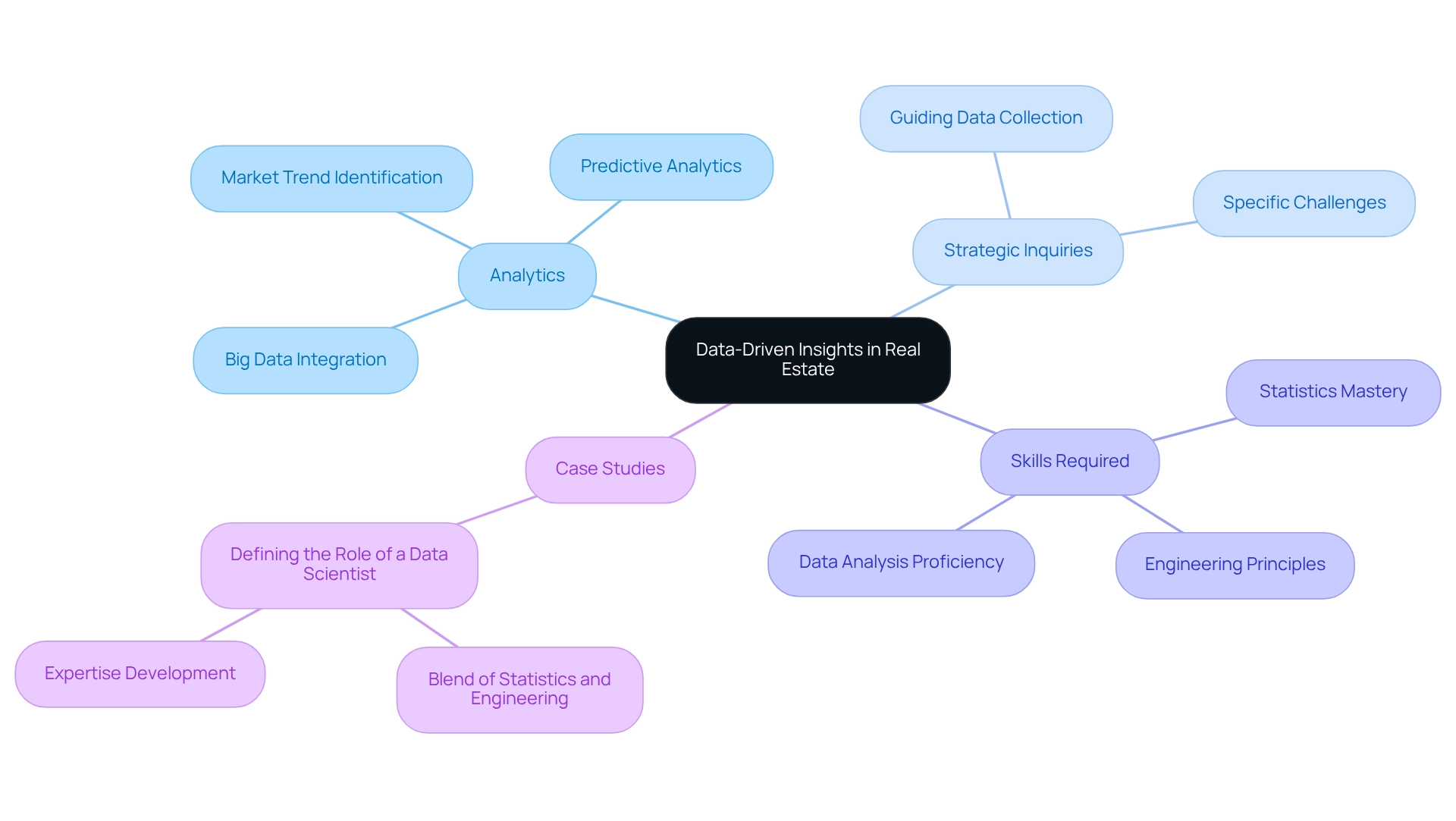
High Financing Costs: Navigating Economic Pressures in Real Estate
In 2025, real estate purchasers face significant challenges stemming from persistently high financing costs. With interest rates remaining elevated, securing affordable capital has become increasingly difficult. This environment necessitates a strategic approach to funding, prompting stakeholders to explore alternative financing options such as:
- Private equity
- Crowdfunding
- Bonds
These methods not only provide access to necessary capital but also mitigate the risks associated with high-interest rates, underscoring the importance of strategic decision-making in this landscape.
Understanding the implications of these financing costs is crucial for making informed investment decisions. As Ben Graham aptly noted, individual participants should act consistently as stakeholders rather than speculators. This emphasizes the need for a disciplined approach in navigating these economic pressures. Moreover, the importance of continuous learning regarding market trends is reinforced by Benjamin Franklin's well-known statement: an investment in knowledge yields the greatest returns, especially given the elevated financing costs. As individuals adjust to the present environment, they must remain vigilant to the effects of interest rates on their holdings.
To effectively navigate the challenges posed by high financing costs in 2025, individuals should consider:
- Leveraging expert opinions
- Analyzing case studies
- Implementing proactive strategies to optimize their funding approaches
By doing so, they can better position themselves to make informed decisions in a complex financial landscape.
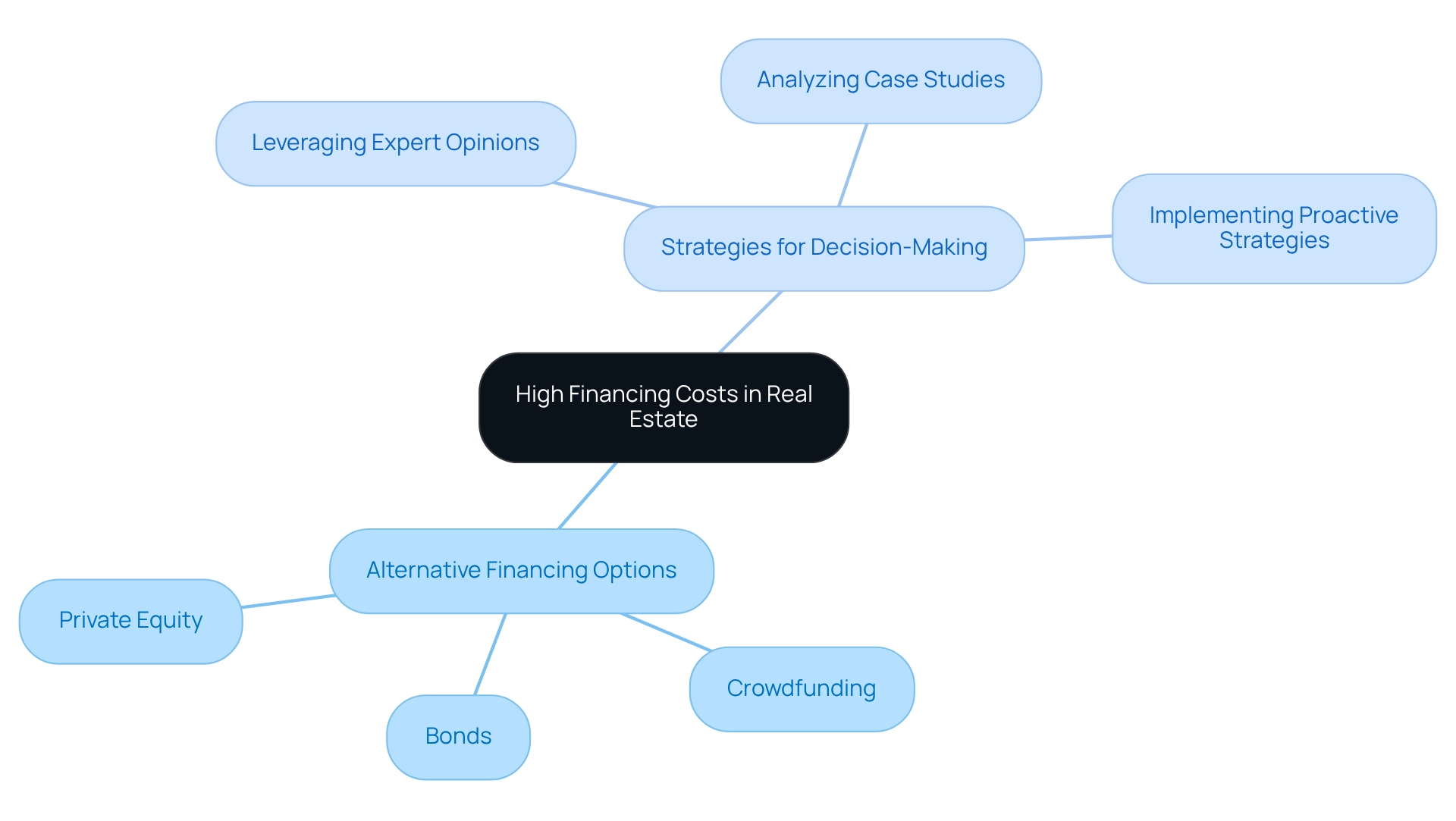
Soaring Insurance Costs: Implications for Commercial Real Estate Investments
In 2025, commercial real estate stakeholders face the daunting challenge of soaring insurance costs, a situation made more complex by the escalating risks associated with climate change. Recent severe weather events—hurricanes, wildfires, and floods—have resulted in substantial hikes in premiums, prompting property owners to reassess their insurance strategies. This trend not only strains operational budgets but also diminishes overall investment returns. With forecasts indicating a rise in billion-dollar extreme weather occurrences by 2030, the necessity for proactive risk management strategies has never been more pressing.
To navigate these challenges effectively, stakeholders should consider adopting comprehensive risk management methods. This may involve:
- Diversifying insurance providers
- Investing in resilient property designs
- Utilizing advanced risk assessment tools
Moreover, understanding the statistics—such as the thirty-one states qualifying for insurance cost forecasts based on a minimum of 15 properties over five years—can empower individuals to make informed decisions. This statistic underscores the importance of regional risk assessments, as varying climate impacts can lead to differing insurance costs across states.
The influence of climate change on insurance premiums is profound, with experts asserting that property owners must adapt to this evolving landscape. As Donna Szatkowski-Zych, Audit & Assurance Partner at Deloitte, highlights, the insurance sector must prioritize sustainability and climate equity to mitigate escalating costs. As insurance expenses continue to rise, the commercial real estate industry trends show that the commercial property sector faces not only financial repercussions but also the imperative for strategic planning to safeguard investments. By prioritizing risk management and remaining attuned to economic trends, investors can enhance their capacity to alleviate the financial pressures associated with increasing insurance costs.

Lingering Office Vacancies: Strategies for Attracting Tenants
As office vacancies persist in 2025, landlords must implement innovative strategies to attract tenants, considering the commercial real estate industry trends. Key tactics include:
- Offering flexible lease terms, appealing to businesses seeking adaptability in uncertain economic conditions.
- Enhancing building amenities—such as modernized common areas and advanced technology—is crucial for improving occupancy rates.
Insights from a recent report on Adaptive Spaces reveal that corporate property executives increasingly prioritize amenities that promote collaboration and productivity, underscoring the necessity for landlords to adjust their offerings.
Furthermore, investing in targeted marketing efforts effectively showcases the unique features of properties to potential tenants. Creating collaborative work environments that align with the evolving needs of modern businesses is another effective approach. By understanding tenant preferences—such as the demand for hybrid workspaces and community-focused designs—landlords can enhance the appeal of their properties.
Current office vacancy rates indicate an urgent need for these strategies, as numerous regions face considerable difficulties. For instance, a recent report highlighted a 36% decline in global real estate investment in 2023, prompting investors to reassess their strategies. This shift emphasizes the importance of adapting to market dynamics and consumer behaviors, including the necessity for financial incentives and pricing resets for conversion projects to remain viable, in light of the commercial real estate industry trends.
Innovative tenant attraction tactics are emerging, with landlords exploring options like rent reductions spread over the initial lease term to ease financial burdens for new tenants. By leveraging these insights and strategies, landlords can navigate the complexities of high vacancy rates effectively and foster a more attractive leasing environment.
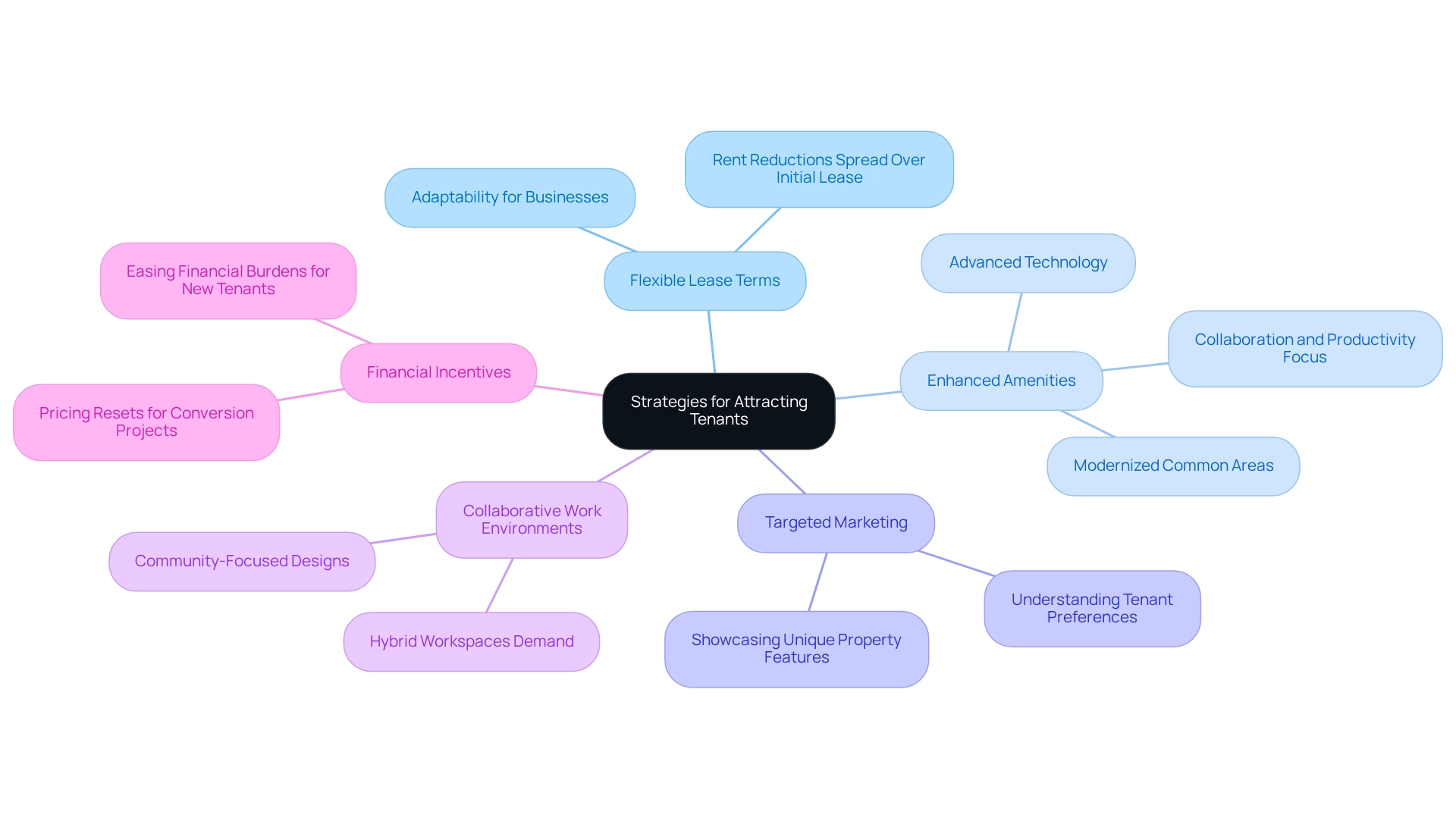
Conclusion
The real estate landscape is rapidly evolving, driven by various factors including technological advancements, changing consumer behaviors, and economic pressures. Zero Flux stands out as a crucial resource, providing daily insights that empower over 30,000 subscribers to navigate these complexities effectively. By highlighting affordable housing opportunities and emphasizing the significance of data-driven decision-making, the newsletter equips investors and stakeholders with the knowledge necessary to make informed choices in a competitive market.
As trends like the rise of move-in ready offices and the resurgence of retail reshape the industry, adaptability emerges as a key factor for success. Investors are encouraged to explore specialized property types, such as data centers and healthcare facilities, capitalizing on current market demands. Furthermore, the integration of ESG considerations underscores the growing importance of sustainability in investment strategies, reflecting a shift towards responsible and impactful real estate practices.
Navigating high financing and insurance costs remains a significant challenge, necessitating innovative strategies and a proactive approach. As commercial real estate faces lingering vacancies, landlords must implement creative solutions to attract tenants, aligning their offerings with the evolving needs of businesses. Ultimately, staying informed and leveraging resources like Zero Flux will be essential for success in this dynamic environment, enabling stakeholders to not only survive but thrive amidst the challenges and opportunities that lie ahead.




